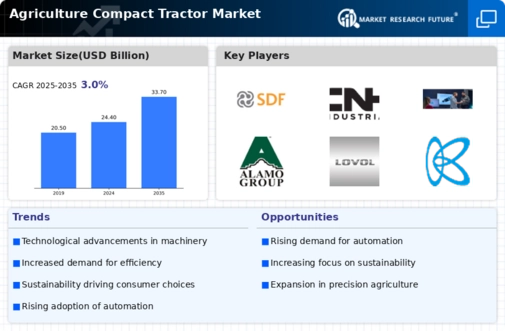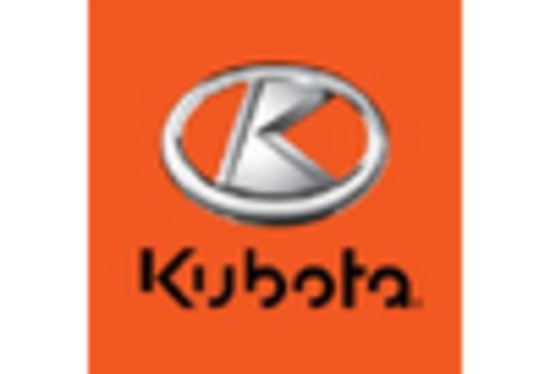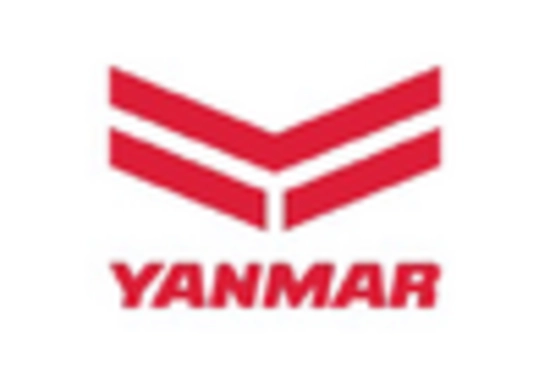Government Support and Subsidies
Government initiatives play a crucial role in shaping the Agriculture Compact Tractor Market. Various governments are implementing policies and providing subsidies to encourage the adoption of modern agricultural equipment, including compact tractors. These initiatives aim to enhance agricultural productivity and ensure food security. For instance, financial assistance programs are available to farmers who invest in advanced machinery, making compact tractors more accessible. In some regions, government grants cover a significant portion of the purchase cost, incentivizing farmers to upgrade their equipment. This support not only stimulates demand for compact tractors but also promotes sustainable farming practices. As a result, the Agriculture Compact Tractor Market is likely to benefit from ongoing government support, which could lead to increased sales and market expansion in the coming years.
Growing Interest in Small-Scale Farming
The Agriculture Compact Tractor Market is witnessing a surge in interest in small-scale farming. As urbanization continues to rise, many individuals are turning to agriculture as a viable source of income and sustenance. This trend is particularly evident in peri-urban areas, where compact tractors are ideal for small plots of land. The versatility and maneuverability of compact tractors make them suitable for various tasks, from tilling to landscaping. Market data suggests that the demand for compact tractors among small-scale farmers is increasing, as these machines provide an efficient solution for limited spaces. This growing interest in small-scale farming is likely to drive the Agriculture Compact Tractor Market forward, as more individuals seek to invest in compact tractors to enhance their agricultural productivity.
Increased Focus on Sustainable Agriculture
Sustainability is becoming a central theme in the Agriculture Compact Tractor Market. As consumers demand more environmentally friendly practices, farmers are increasingly adopting sustainable agricultural methods. Compact tractors, with their smaller size and lower fuel consumption, align well with these practices. The market is witnessing a shift towards tractors that minimize environmental impact while maximizing efficiency. Data indicates that the adoption of sustainable farming practices is expected to rise, leading to increased demand for compact tractors that support these initiatives. Furthermore, manufacturers are responding to this trend by developing eco-friendly models that cater to the needs of environmentally conscious farmers. This focus on sustainability is likely to shape the future of the Agriculture Compact Tractor Market, as it aligns with broader global efforts to promote responsible farming.
Rising Demand for Efficient Farming Solutions
The Agriculture Compact Tractor Market is experiencing a notable increase in demand for efficient farming solutions. As agricultural practices evolve, farmers are seeking compact tractors that offer versatility and ease of use. The need for efficient land management and crop production drives this demand. According to recent data, the compact tractor segment is projected to grow at a compound annual growth rate of approximately 5.2% over the next five years. This growth is attributed to the rising adoption of precision agriculture techniques, which require advanced machinery to optimize productivity. Furthermore, the increasing focus on reducing labor costs and enhancing operational efficiency further propels the market for compact tractors. Farmers are increasingly recognizing the value of investing in compact tractors that can perform multiple tasks, thereby improving overall farm productivity.
Technological Innovations in Compact Tractors
Technological innovations are transforming the Agriculture Compact Tractor Market, making tractors more efficient and user-friendly. The integration of smart technologies, such as GPS and telematics, allows farmers to monitor and manage their operations more effectively. These advancements enhance precision farming, enabling better resource allocation and reduced waste. Additionally, the introduction of electric and hybrid compact tractors is gaining traction, appealing to environmentally conscious farmers. Data indicates that the market for electric compact tractors is expected to grow significantly, driven by the increasing emphasis on sustainability. As these technologies continue to evolve, they are likely to reshape the competitive landscape of the Agriculture Compact Tractor Market, attracting new players and fostering innovation.

















Leave a Comment